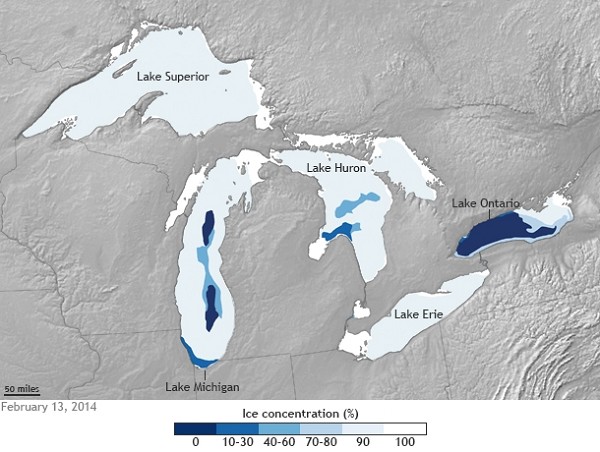
NASA photo shows percent of ice cover on the Great Lakes on Feb. 13, 2014. Blue areas are open water.) WATER TO RISE? 88.4 Percent Great Lakes Freeze Sets 20 Year Record
February 27, 2014
Leave a Comment
|
||||||||||
| Printer Friendly Story View |
Sportsmen and boaters are looking forward to higher levels of the Great Lakes this spring because of the cold winter and extensive ice cover, greatest in the past 20 years.
The effects of extensive ice cover could even last into the summer and fall, potentially contributing to cooler water temperatures, NOAA (National Oceanic and Atmospheric Administration) experts said.
Since the ice must be melted first before the water below it can be warmed, the lakes could heat up slower -- although weather conditions and heat storage in the lakes will be contributing factors as well, according to the GLERL (Great Lakes Environmental Research Laboratory) website.
Maximum ice cover on the lower lakes normally occurs between mid-February and end of February, while the maximum on the upper lakes normally occurs between the end of February and early March. According to the Midwest Regional Climate Center, average temperatures were below normal across the region during the second week of February. If cold temperatures persist, the MRCC reports, "it is possible that the Great Lakes could approach the record-setting year of 1979, which recorded 94.7 percent maximum ice coverage."
(Note: The photo above shows the percent of ice cover on the Great Lakes on February 13, 2014. Shades of blue indicate ice concentration, with the darkest shade of blue indicating areas where 0 percent of the water's surface is frozen, and white indicating areas where the water is entirely frozen over.)
Lower water temperatures could also potentially reduce evaporation from the lakes this year, which could help drive water levels up.
Ice cover on the Great Lakes reached 88 percent in mid-February 2014, levels not observed since 1994, reports NOAA (National Oceanic and Atmospheric Agency).
The average maximum ice extent since 1973 is just over 50 percent. It has surpassed 80 percent just five times in four decades.
Nathan Kurtz, cryospheric scientist NASA's Goddard Space Flight Center, said persistently low temperatures across the Great Lakes region are responsible for the increased area coverage of the ice.
Cold air and winds remove heat from the fresh water until it reaches the freezing point, at which point ice begins to form on the surface, Kurtz added.
Low temperatures are the dominant mechanism for thickening the ice, but secondary factors like clouds, snow, and wind also play a role.
Scientists say that there was an early ice season this year, owing to cold temperatures in the fall and early winter. Ice was reported on bays and harbors of the Great Lakes as early as the end of November, as opposed to the normal timing of mid-December.
According to an analysis by NOAA's Great Lakes Environmental Research Laboratory, ice covered 88.4 percent of the Great Lakes on February 13. Not since early 1994 has ice been so widespread on the Great Lakes.
This is an abrupt turn around from the past four winters, during which the peak ice coverage remained around 40 percent or less, the Weather Channel's Jon Erdman wrote. The 40-year average is just over 51 percent.
Persistent cold temperatures in the Midwest this winter have almost completely frozen over many of the Great Lakes. The Great Lakes Environmental Research Laboratory (GLERL) reported that 88 percent of the Great Lakes were frozen as of mid-February. The last time ice cover was even close to this extent was in 1996, when maximum seasonal ice cover was approximately 82 percent.
On Feb. 13, Lakes Superior, Erie, Huron, and St. Clair were 90-100 percent ice covered, while Lakes Michigan and Ontario were 82 percent and 43 percent ice covered, respectively. Overall, 88 percent of the Great Lakes were frozen on this date -- the most extensive total ice coverage observed so far this winter.
But while ice cover and water levels are known to vary on the Great Lakes from year to year, scientists have observed an overall decrease in ice extent since records began in the early 1970s. From 1973 to 2010, annual ice coverage on the Great Lakes declined by 71 percent (relative to 1973).
Percent ice cover on the Great Lakes at winter maximum each year since 1973. Prior to the mid-1990s, most years were above the long-term average; since then, most years have been below average.
So far this winter, extensive ice cover has allowed access into previously inaccessible ice caves near Lake Superior and provided a safe landing spot for an airplane experiencing an emergency over Lake Huron.
| Printer Friendly Story View |
|
|

Dave Rogers |
|
|
|
Printer-Friendly Story View
0200 Nd: 04-15-2024 d 4 cpr 0
12/31/2020 P3v3-0200-Ad.cfm
SPONSORED LINKS
12/31/2020 drop ads P3v3-0200-Ad.cfm


